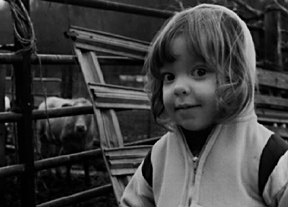Two-year old Heather rides on her father's lap in the tractor cab as dad mows his field. Distracted by a butterfly at the window, she slips off his lap and is jostled against the door, which swings open. She falls out and is crushed by the tractor's rear wheel before her father has time to react. Her death is reported as another "tragic farm accident."

Each year, hundreds of children like Heather are hurt or killed while playing or working on the family farm. Farm accidents involving children may seem unpredictable and random. It may seem that they can't be prevented. Some people even believe they are simply "the price of farming."
In fact, farm accidents to children are not random. They are very predictable. And almost all of them could be prevented, according to child and farm safety experts.
Farm injuries happen when a child is doing something that is beyond his or her mental, physical or emotional ability. As they grow, all children pass through a series of developmental stages that take them from toddler to teenager. The physical changes are obvious, as a child grows taller and stronger. But along with physical changes come changes in mental and emotional development that are sometimes harder to recognize.
By understanding the stages of a child's growth and development and by providing careful supervision and training that's right for each stage, parents and other adults can protect farm kids.
The chart on the back describes typical developmental stages, risks that farm kids at each stage may take, and appropriate protective measures. How well does this chart describe the youngest farmers in your household or community? Are there ways you can better protect the farm children you care about?
| Characteristics | Typical Risks | Protective Measures |
|
Toddler/Preschooler Unable to understand cause and effect Illogical, "magic" thinking Fascinated by movement or moving parts May love to climb Curious |
Drinking or eating poison Falling off farm equipment or pickup truck Drowning in pond or manure pit Wandering into highway |
Careful supervision at home or in childcare Physical barriers such as locks & fences Safe distractions Prohibiting riding on farm machinery |
|
Early School Age (5-9) Inconsistent use of logic Wishes to appear competent Wants adult approval Not aware of realistic dangers-more fearful of kidnapping or war than of much more likely farm accident |
Livestock kicks or crushing Entanglement in augers or other moving machinery Falling out of tractor or pickup |
Consistent rules Discussion of safe behavior Assignment of simple farm chores, with careful supervision Bike safety training and use of bike helmet |
|
Older School Age (10-13) Greater physical and mental skills Physical development may outstrip mental or emotional maturity Wants social and peer acceptance Wishes to practice new skills without constant adult supervision |
Operating machinery designed for adults. Being struck by a car while riding bicycle Falling from hay loft or ladder |
Consistent rules, with consequences for infractions and rewards for safe behavior Bike safety classes, use of bike helmet Deliberate, planned increases in chores and responsibilities Specific education on farm hazard avoidance |
|
Adolescent (13-16) Desire to experiment Strong need for peer acceptance Resistance to adult authority |
Machinery rollover or roadway accident Hearing loss from exposure to loud machinery Head or spine injury from motorcycle or ATV accident |
Education from peers who have experienced injury or illness themselves Consistent rules, with predictable consequences for infractions and rewards for safe behavior Motorcycle and ATV safety education and use of helmets Involvement in farm safety projects through 4-H, FFA and other groups |
|
Young Adult (16-18) Increasing sense of adult responsibility and competence Desire to be supportive, take on adult share of farm work Need to take risks Feeling of "immortality" |
Same as adult risks: respiratory illness, tractor or machinery rollover or entanglement, hearing loss, muscle or bone injuries Additional risk from experimentation with alcohol or drugs |
Clear and consistent rules regarding drugs and alcohol Rewards for acceptance of adult responsibilities Opportunity to be role model, teaching younger children about farm safety |
If you'd
like to know more about child farm safety, contact your local
extension agent, or State Extension Agricultural Safety and
Health Specialist.
Produced by the Educational Development System, University of Minnesota Extension Service.
In accordance with the Americans with Disabilities Act, this material is available in alternative formats upon request. Please contact your Minnesota county extension office or, outside of Minnesota, contact the Distribution Center at (612) 625-8173.
The University of Minnesota Extension Service is committed to the policy that all persons shall have equal access to its programs, facilities, and employment without regard to race, color, creed, religion, national origin, sex, age, marital status, disability, public assistance status, veteran status, or sexual orientation.
Disclaimer and Reproduction Information: Information in NASD does not represent NIOSH policy. Information included in NASD appears by permission of the author and/or copyright holder. More